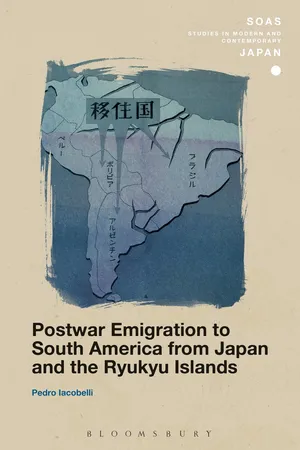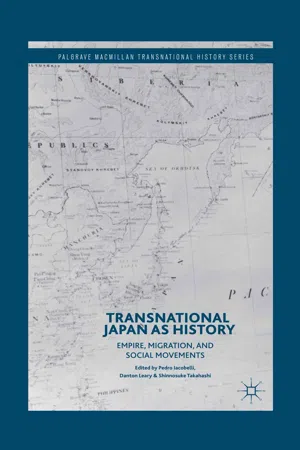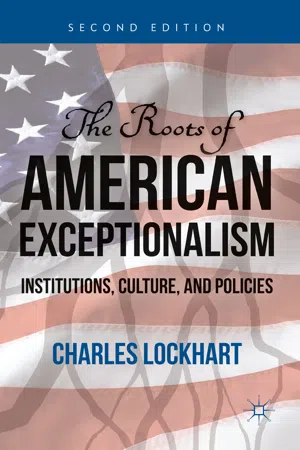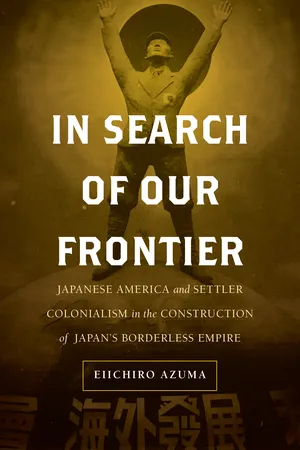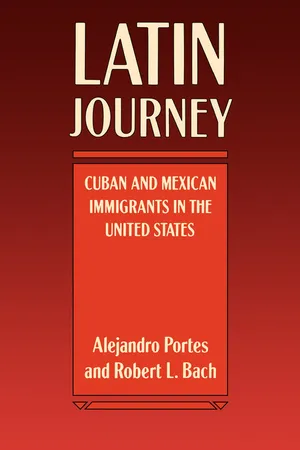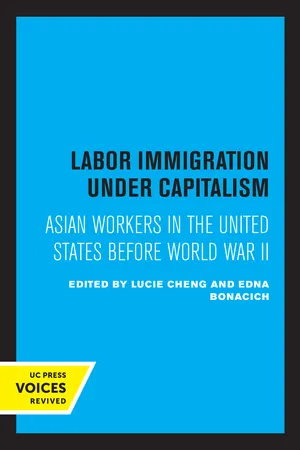History
Japanese Immigration
Japanese immigration refers to the movement of Japanese people to other countries, particularly in the late 19th and early 20th centuries. This migration was driven by economic opportunities and labor demands in countries such as the United States, Brazil, and Canada. Japanese immigrants faced challenges such as discrimination and restrictive immigration policies in their new homelands.
Written by Perlego with AI-assistance
Related key terms
1 of 5
12 Key excerpts on "Japanese Immigration"
- eBook - PDF
Migration and Immigration
A Global View
- Maura I. Toro-Morn, Marisa Alicea, Maura I. Toro-Morn, Marisa Alicea(Authors)
- 2004(Publication Date)
- Greenwood(Publisher)
HISTORY OF MIGRATION ISSUES Emigration Population shifts in Japan have long been tied to historical developments. While there had always been immigration back and forth between Japan and the Asian mainland (especially Korea and China), Europeans began arriving in the fourteenth century during the western "Age of Exploration." The Tokugawa shoguns, however, after finally unifying Japan after centuries of intermittent civil war, closed the country around 1600 C.E., ostensibly to eradicate Christianity from the nation's shores. European traders and mis- sionaries had brought their political and religious conflicts with them as they traveled throughout Asia, and the Japanese government lost patience trying to make sense of these differences. Also, the shoguns worried about how much influence the Europeans had over the local warlords and feared re- newed uprisings if they became too powerful. In any case, the nation sealed it borders, preventing Japanese from leaving and foreigners from entering for the next 250 years. It was not until the American commodore Matthew Perry "opened" the islands in the middle of the nineteenth century that Japan again had legal intercourse with the rest of the world. 116 MIGRATION AND IMMIGRATION Soon after the period of national isolation ended, the "Japanese diaspora" began. Though not as well known as some of the other great migrations in world history—for example, the Jewish, Irish, African, or Chinese diaspo- ras — the Japanese diaspora was nonetheless large and significant. As we saw in the case of former Peruvian President Fujimori's family, the instant contact with the West caused great social and economic upheavals in Japan around the turn of the twentieth century. Rural areas were especially hard hit, forc- ing many Japanese farmers to seek work overseas, particularly in Latin Amer- ica, Hawaii, and mainland North America. - Pedro Iacobelli(Author)
- 2017(Publication Date)
- Bloomsbury Academic(Publisher)
Our visions of Japanese emigration history are drawn from various sources: objects and artifacts used by the pioneers; government statistics and advertisements from the migration programs; a wealth of personal and collective accounts of a migration process, which normally emphasize the shaping of a community of migrants and the legacy of such migration in the host country; newspaper articles published at the time of the migration; historical novels; and more recently electronic media like the Internet. History books are among these sources and, at a scholarly level, are complemented by other disciplines, notably by anthropology and ethnic studies. Our thoughts of Japanese migration history are also shaped by frameworks that inscribed a variety of primary and secondary sources into a cohesive narrative. This chapter brings to the stage a framework that puts the central role played by states in the formation of migration movements in East Asia into context while also presenting the most important characteristics of the history of Japanese migration to South America. “Political migration history” is an approach to historical migration, and it serves as a template to examine postwar Japanese cases, such as the one from Okinawa and mainland Japan to Bolivia. In this framework, the relationship between the state and its population is fundamental in understanding the determinants of emigration. As seen in the Introduction, theorists from different periods concurred on the idea that the state is a reality that can only find its political justification in its population. Since the state is embedded in society, there is an axiomatic interdependence between state practices and other social practices. 1 Within this close connection between the state and its apparatuses and the population, we may find some of the causes that enable international migration flows.- eBook - ePub
Japan and Global Migration
Foreign Workers and the Advent of a Multicultural Society
- Mike Douglass, Glenda Roberts(Authors)
- 2015(Publication Date)
- Routledge(Publisher)
et al. 1996).In fact, Japan is not only a product of distinct waves of large-scale immigration from different origins in ancient times, it has benefited from the influx of other peoples and cultures for a long period leading up to the present time (McCormack 1996).7 Its world-renowned ceramics industry, for example, was greatly stimulated by the import of Korean potters in the early seventeenth century. Yet throughout all this history, the policy of government and practice of Japanese society has been to pretend that immigration was not occurring and to require foreigners either to live in officially-designated enclaves or otherwise to be contained in specific neighborhoods.8 The Chinese and Korean residents mentioned earlier are also considered to be outside the category of immigrants.In the late 1970s the wave of migration to Japan of female recruits for the sex and entertainment industry presented a potential confrontation to the policy of not allowing foreign workers to migrate to Japan. Gender and other biases meant that the thousands of foreign women entering Japan from this period onward were even more invisible than were the Chinese and Korean male workers who had preceded them in the earlier migration stream of the pre-Second World War period. It was only when male immigration began to increase dramatically after 1986 that the immigration of women began to receive attention (Ito 1992, Yamanaka 1994). By the 1990s an estimated 100,000–200,000 women, largely recruited through organized crime networks, were entering Japan each year to work as bar hostesses and prostitutes. This type of immigration of women for the sex trade is itself a continuation of a century-long involvement of Japan in the international organization of prostitution in Asia beginning in the late nineteenth century. During the Second World War, as many as 200,000 “comfort women” from Japan’s conquered territories were forced to prostitute themselves for Japanese troops.9 - eBook - PDF
- Y. Sellek(Author)
- 2000(Publication Date)
- Palgrave Macmillan(Publisher)
1 Historical Context and Evolution of Foreign Migrant Workers in Contemporary Japan The main purpose of this chapter is to present an overview of foreign workers in contemporary Japan. It first examines briefly the historical context of migration and emigration in Japan since the beginning of the twentieth century and then offers various reasons to explain how Japan managed to achieve high economic growth without relying on foreign workers engaged in the unskilled job sectors during the 1960s and 1970s. Next, the chapter draws a general picture of the skilled foreign workforce and reviews the flow of illegal foreign workers into Japan since 1981. Finally, the chapter examines the reasons for the significant increases in the number of foreign workers since the mid-1980s. Historical context In historical terms, Japan has experienced streams of both immigrants and emigrants for a very long time. In this sense, the recent problems associated with foreign workers are not new. A brief explanation regard- ing the path which Japan has taken to achieve its own version of `modernization' is necessary in order to sketch out the history of migra- tion in Japan. If we restrict our analysis to the post-Edo period (that is, 1868 onwards when the country began to self-modernize in the face of Western power, exemplified by the so-called `unequal treaties') the Japanese leadership responded to Western power by prioritizing its congruence of interests with the West by importing Western learning, while maintaining an indigenous identity (Hook, 1996, p. 171). During this period the new leadership of Japan tried to steer the country towards a role on the world stage as a modern `nation' which was 15 16 Migrant Labour in Japan recognized as having a military, political and economic identity in the advanced West. - Philip E. Vernon, David T. Lykken(Authors)
- 2013(Publication Date)
- Academic Press(Publisher)
3 Immigration of Japanese to the United States CHRONOLOGY Sixteenth and seven- teenth centuries Portuguese traders and missionaries in Japan. 1637 Virtual isolation from outside world for over 200 years. 1603- Japan ruled by Tokugawa Shogunate, nominally under the emperor. 1868 1854 United States, Russia, England, and Holland allowed to open diplo- matic and trade relations. 1868 Fall of shogunate; emperor's authority reestablished. Meiji era. Rapid modernization of Japan, helped by foreign nations. 1884-85 First immigration of Japanese to Hawaii, United States, and Canada. 1894-95 First war with China. Part of Manchuria ceded, and Korea made independent. 1904-05 Japanese war with Russia. 1907 "Gentleman's Agreement" restricted Japanese Immigration to United States. 1913 California Land Act prohibited ownership or leasing of land to Orien- tals. 1924 Immigration Act barred all oriental immigration to United States (with few exceptions). 1915 Japanese invaded China. Imposed " 2 1 D e m a n d s . " 1931-37 Further war with China, in defiance of League of Nations. Nanking massacre. Puppet government installed. 1930s Severe deterioration in Japan-United States relations. Demand by Japan for large navy. 34 Early History 35 1941 Pearl Harbor attacked on December 7. Declaration of war by United States and Britain. 1942 Evacuation inland of all West Coast Japanese Americans and Canadians. 1943 Many Japanese in relocation centers allowed to settle further east. 1945 Camps closed. 1946 New constitution imposed on Japan. Emperor's authority removed. 1954 Racial discrimination laws abolished. SOURCES OF INFORMATION Among the most useful books and articles are those by Kitano (1969), Strong (1934), Benedict (1946), Gulick (1947), Grodzins (1949), Daniels (1975), Lyman (1970), Petersen (1971), Miyamito (1973), and Lebra (eds.) (1974). For post-war developments: Stoetzel (1955), Bennett et al (1958), Caudill (1973), Forbis (1975), and Vogel (1979).- eBook - PDF
Transnational Japan as History
Empire, Migration, and Social Movements
- Pedro Iacobelli, Danton Leary, Shinnosuke Takahashi, Pedro Iacobelli, Danton Leary, Shinnosuke Takahashi(Authors)
- 2016(Publication Date)
- Palgrave Macmillan(Publisher)
121 5 Migrations and the Formation of a Diverse Japanese Nation during the First Half of the Twentieth Century Noriaki Hoshino Beginning with the Meiji period, Japanese population movements outside of the country followed the narratives that accompanied the expansion of the Japanese empire. Beyond the development of set- tler colonialism in Japanese colonies in East Asian countries, Japanese migrations to North American countries were also expected to estab- lish a “new Japan” ( shin nihon) across the Pacific. 1 In this context, recent studies of Japanese migration to the United States have started focusing on the connection between Japanese transpacific migra- tions and the Japanese imperial expansion in East Asia. For exam- ple, a representative work of this phenomenon, written by historian Eiichir ō Azuma, reveals how the experience of Japanese migrants in the United States was later appropriated by Japanese imperialists to support and promote the Japanese colonial migrations to Manchuria in the 1930s. 2 In view of such discussions of the close relationship between trans- pacific migration and Japanese imperial expansion in East Asia, this study introduces another thematic concern: the problem of racial/ ethnic relationships within and outside of the Japanese empire. Migration and racial/ethnic contacts are popular topics, usually con- joined, in the study of colonialism, but previous studies of Japanese migrations have not examined how best to situate this issue of the empire’s racial/ethnic relationships on the spectrum of evolving dis- course on Japanese migrations. This chapter pursues such an inquiry by examining the discourses and activities of Nagata Shigeshi (1881–1973), the second president of the Japanese Christian organization, Nihon Rikk ōkai (Japanese Striving Association), and his predecessors. Nihon Rikk ōkai is a - eBook - PDF
The Japanese Community in Brazil, 1908 - 1940
Between Samurai and Carnival
- S. Lone(Author)
- 2001(Publication Date)
- Palgrave Macmillan(Publisher)
In one sense, this was to expose them- selves to possible mistreatment as an alien minority. At the same time, however, it offered these emigrants the opportunity to con- trol their own affairs and assume responsibility for their own safety. Whether emigration was to prove a case of freedom or persecution ultimately depended on the reaction to Japanese of their various host societies; where there was fear of Japanese as an aggressive warrior people, the migrant’s position was insecure; where this fear either did not exist or was a minority view (even if it did occa- sionally fill the press headlines), the migrant had a better chance to prosper. The first large-scale appearance of Japanese outside their four main islands dates from the 1880s. This was not counterbalanced at the time by any equivalent rise in the number of foreigners within Japan; in 1896, the foreign population of Tokyo was estimated at just 628 and direct contact within Japan between Japanese and non-Japanese was rare. 1 Emigrants heading overseas, however, went initially to island societies with an agrarian economy. In this, they were following the lead of a small number of pioneers from 1868 who had sought jobs in Hawaii and Guam. In this early case, abuse from employers in Hawaii and friction in Guam had forced the Japanese government to repatriate the migrants within a matter of months. This unsatisfactory (and technically illegal) first experience of labour emigration militated Leaving: 1885–1905 13 against further dispatches of Japanese workers overseas. However, by the mid-1880s the majority rural population was suffering greatly from the impact of a new and rigid land tax system plus deflationary monetary policies which set the price of rice back to the level of a decade earlier. Japan’s still infant urban industries were concentrated mainly in the central regions and were as yet incapable of providing alternative jobs for a mass of impoverished farmers. - eBook - PDF
The Roots of American Exceptionalism
Institutions, Culture, and Policies
- C.(Author)
- 2012(Publication Date)
- Palgrave Macmillan(Publisher)
In particular, we should anticipate that most migrants will be allowed entry only for the short term (e.g., tourists, students, trainees, workers offering specific capacities which are in demand in the Japanese economy). Sophisticated outsiders who are capable of serving some im- portant need recognized by Japanese central-state executives may be al- lowed to stay longer. But it would be surprising if any significant proportion of even these persons were granted full membership in soci- ety in terms of being allowed citizenship. Citizenship might be extended to a select few on the basis of assimilation. That is, persons who could “pass for” Japanese in both appearance and behavior (e.g., language) would be more likely candidates for citizenship than others. U.S. IMMIGRATION AND CITIZENSHIP POLICY American policies toward immigration have varied across time (Archdeacon 1983; Jones 1992). Overall, however, regulation of immi- gration has been fairly modest. Prior to the mid-1870s there were virtu- ally no restrictions on entry into the United States. Some restrictions were initiated in 1877, but they were focused narrowly on what various nativists viewed as particularly “undesirable” persons (e.g., convicts, pros- titutes, Asian workers). 4 More systematic restrictions were introduced in the early 1920s in the aftermath of particularly high levels of immigra- tion. For over a quarter-century thereafter, the overall level of immigra- tion allowed varied with social dislocations outside the United States and responding peaks in American nativist reaction. Across this period, re- strictions fell much more heavily on non-European immigrants, particu- larly Asians who—while admitted in limited numbers as unskilled laborers—were not permitted to bring family members with them. Dur- ing the first two decades following the Second World War, regulation of American immigration became much more even-handed. - eBook - PDF
Asian Americans
Contemporary Trends and Issues
- Pyong Gap Min(Author)
- 2005(Publication Date)
- SAGE Publications, Inc(Publisher)
THEORIES USEFUL FOR UNDERSTANDING ASIANS’ IMMIGRATION TO THE UNITED STATES A close examination of Asians’ international migration to the United States should include a discussion of its causal factors, that is, what factors have caused them to cross the Pacific to live in this country temporarily or permanently. To explain international migration, social scientists have developed various theories. I consider the follow-ing four factors most useful to understanding Asians’ transpacific migration to the United States: (a) the push and pull factors; (b) the immigration policy of the U.S. government and the emigration policy of each Asian country; (c) the military, political, and economic linkages between the United States and each Asian country; and (d) globalization and the easiness of population movement. These four causal factors, couched in four theories, complement one another to help us understand the origin of Asian immigration to the United States. The push-pull theory is the oldest theory of international migration and focuses on individ-ual immigrants’ motivation to leave their home country for a new country for temporary or per-manent residence. The push factors can be eco-nomic difficulty caused by famine or changes in industrial structure (economic migration) or dis-crimination and even physical insecurity due to one’s minority status, a change in government, or war (refugee migration). The pull factors include better economic and career opportunities, better opportunities for children’s education, and politi-cal freedom (Lee, 1966; Todaro, 1969). Both the earlier and post-1965 Asian immigrants were mostly pushed out of their country by famine, other economic difficulties, or the threat to physical security due to the change in government. They were also attracted to the United States by the prospect for more economic, educational, and career opportunities, as well as religious and political freedom. - eBook - PDF
In Search of Our Frontier
Japanese America and Settler Colonialism in the Construction of Japan's Borderless Empire
- Eiichiro Azuma(Author)
- 2019(Publication Date)
- University of California Press(Publisher)
99 The Colonization Society also adopted this promigration agenda, demanding that the government consider the meaning of migration from a long-term perspective—a perspective that appreci-ated not only its economic benefits but also migration’s role in extending Japanese influence externally and moderating the rapid population increase at home. 100 Indeed, as historian Sidney Xu Lu argues, the problem of population control had constituted an element that could not be ignored in Japanese migration dis-course since the 1880s. The earliest Japanese translation of Thomas Robert Malthus’s An Essay on the Principle of Population came out in 1877, and several years later Japan’s first generation of expansionist ideologues, including Fukuzawa Yukichi, already entertained the idea of overseas emigration and settler colonial-ism as a combined solution to anticipated problems of overpopulation and unem-ployment that seemed always to follow national modernization and technological advancement. 101 Ever paranoid about overpopulation’s anticipated perils, the social elite of Meiji Japan started to detect the stifling effects of population “explosion” as the end of the nineteenth century neared. By the outbreak of the Russo-Japanese War, the fallout of industrial development was rampant in Japanese society in the form of rigid class stratification and political disorder, catalyzing the subsequent rise of socialist/anarchist movements against Japan’s capitalist system and the imperial institution itself. It was this domestic turn of events against which more Vanguard of an Expansive Japan 83 and more proponents of national expansion—especially armchair theorists and politicians in Japan such as Hoshi Tōru—came to understand the imperative of writing mass labor migration into their definitions of settler colonialism. - eBook - PDF
Latin Journey
Cuban and Mexican Immigrants in the United States
- Prof. Alejandro Portes, Robert L. Bach(Authors)
- 1985(Publication Date)
- University of California Press(Publisher)
Under very different circumstances, Japanese Immigration to the West Coast followed a similar adaptation pattern. Significant Japanese immigra-tion to the mainland did not start until 1890. From that year until 1908, about 150,000 male immigrants came. After the Gentlemen's Agreement of 1908, Japanese arrivals were predominantly the spouses of earlier immi-grants, until the 1924 Immigration Act banned all further Asiatic immigra-tion. During the entire period, there were fewer than 300,000 Japanese recorded as entering the United States. 24 This figure does not take into account the return flow and, hence, overestimates the actual size of net immigration. From 1908 to 1924, for example, the 160,000 Japanese immi-grants resulted in a net inflow of only 90,000. The 1920 census counted 111,010 Japanese in the United States out of a total population of 106,000,000. 25 Several authors have commented on the discrepancy between the tiny size of this group and the magnitude of the public reaction to it. Repeatedly, the California press and the labor movement engaged in virulent campaigns against the Japanese invasion. In 1905, both houses of the California legisla-ture passed a resolution asking Congress to limit further Japanese immigra-tion. Included in a long bill of particulars was the following statement: Japanese laborers, by reason of race habits, mode of living, disposition, and general characteristics, are undesirable. . . . They contribute nothing to the growth of the state. They add nothing to its wealth, and they are a blight on the prosperity of it, and a great impending danger to its welfare. 26 For the next forty years, not a single session of the California legislature ended without at least an attempt to pass one more piece of anti-Japanese legislation. 27 One reason for such hostility was that, like Jews back East, the Japanese were highly concentrated and resisted efforts at dispersal. - eBook - PDF
Labor Immigration under Capitalism
Asian Workers in the United States Before World War II
- Lucie Cheng, Edna Bonacich, Lucie Cheng, Edna Bonacich(Authors)
- 2023(Publication Date)
- University of California Press(Publisher)
The final path chosen may have had more of a relationship with the type of thinking and initiative shown by later Japanese who emigrated abroad. Sumiya points out that a large number of young men left the farms to work in remote factories and mines. 3 1 These were the type of workers who would form the basis of the urban labor force. For our purposes, the formation of this group of workers represents an impor- tant step in the development of internal migration patterns in Japan. Studies of villages in the Tokugawa period (1601 to 1867) have indi- cated the effects of permanent and temporary migration on fertility and population increases in the countryside. 3 2 It is important to note that temporary migration (dekasegi rodo) of workers to towns and cities on a labor contract of a year or longer began in Tokugawa Japan. 3 3 This type of labor migration had other characteristics that would also be notice- able in emigration to Hawaii. Hanley and Yamamura have pointed out in Economic and Demographic Change in Preindustrial Japan 1600-1868 that not only were these migrating workers young and single but it was not unusual for heads of families to leave their villages. 34 Whereas in the Tokugawa period survivors of economic crisis occa- sionally traveled to find jobs, in the Meiji period there was an increase in the number of young workers leaving the countryside for work in the cities. In terms of later patterns, the important legacy of this internal migration is not that these workers were going to the cities but that they were willing to leave their villages and travel to a distant place to find work. Although it is impossible to prove that those who eventually left Japan to work in Hawaii had previously migrated to work in Japa- nese cities, it seems reasonable to assume that the rise of internal migration at least gave some legitimacy to this process.
Index pages curate the most relevant extracts from our library of academic textbooks. They’ve been created using an in-house natural language model (NLM), each adding context and meaning to key research topics.

